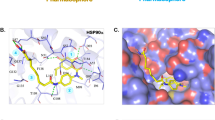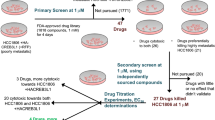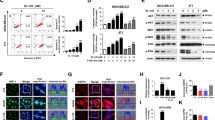Abstract
17-Allylamino-17-demethoxygeldanamycin (17-AAG) is a new anticancer agent currently in clinical trials. The ability of 17-AAG to abrogate the function of heat-shock protein Hsp90 and modulate cellular sensitivity to anticancer agents has prompted recent research to use this compound in drug combination therapy. Here we report that 17-AAG has striking opposite effects on the activity of arsenic trioxide (ATO) and ara-C. Combination of 17-AAG with ATO exhibited a synergistic effect in leukemia cells, whereas coincubation of 17-AAG and ara-C showed antagonistic activity. Mechanistic studies revealed that ATO exerted cytotoxic action by reactive oxygen species generation, and activated Akt survival pathway. 17-AAG abrogated Akt activation and enhanced the activity of ATO. In contrast, treatment of leukemia cells with 17-AAG caused a G1 arrest, a decrease in DNA synthesis and reduced ara-C incorporation into DNA, leading to antagonism. The ability of 17-AAG to enhance the antileukemia activity of ATO was further demonstrated in primary leukemia cells isolated from patients with acute myeloid leukemia and chronic lymphocytic leukemia, including cells from refractory patients. Our data suggest that combination of 17-AAG and ATO may be an effective therapeutic regimen. Caution should be exercised in using 17-AAG together with ara-C, as their combination effects are schedule dependent.
This is a preview of subscription content, access via your institution
Access options
Subscribe to this journal
Receive 12 print issues and online access
$259.00 per year
only $21.58 per issue
Buy this article
- Purchase on Springer Link
- Instant access to full article PDF
Prices may be subject to local taxes which are calculated during checkout






Similar content being viewed by others
References
Young JC, Moarefi I, Hartl FU . Hsp90: a specialized but essential protein-folding tool. J Cell Biol 2001; 154: 267–273.
Neckers L . Heat shock protein 90 inhibition by 17-allylamino-17-demethoxygeldanamycin: a novel therapeutic approach for treating hormone refractory prostate cancer. Clin Cancer Res 2002; 8: 962–966.
Neckers L . Hsp90 inhibitors as novel cancer chemotherapeutic agents. Trends Mol Med 2002; 8: S55–S61.
Dunn FB . Heat shock protein inhibitor shows antitumor activity. J Natl Cancer Inst 2002; 94: 1194–1195.
Schulte TW, Neckers LM . The benzoquinone ansamycin 17-allylamino-17-demethoxygeldanamycin binds to HSP90 and shares important biologic activities with geldanamycin. Cancer Chemother Pharmacol 1998; 42: 273–279.
Hostein I, Robertson D, DiStefano F, Workman P, Clarke PA . Inhibition of signal transduction by the Hsp90 inhibitor 17-allylamino-17-demethoxygeldanamycin results in cytostasis and apoptosis. Cancer Res 2001; 61: 4003–4009.
Schulte TW, Blagosklonny MV, Ingui C, Neckers L . Disruption of the Raf-1–hsp90 molecular complex results in destabilization of Raf-1 and loss of Raf-1–Ras association. J Biol Chem 1995; 270: 24585–24588.
Whitesell L, Shifrin SD, Schwab G, Neckers LM . Benzoquinonoid ansamycins possess selective tumoricidal activity unrelated to src kinase inhibition. Cancer Res 1992; 52: 1721–1728.
Whitesell L, Mimnaugh EG, De Costa B, Myers CE, Neckers LM . Inhibition of heat shock protein HSP90–pp60v–src heteroprotein complex formation by benzoquinone ansamycins: essential role for stress proteins in oncogenic transformation. Proc Natl Acad Sci USA 1994; 91: 8324–8328.
Blagosklonny MV . Hsp-90-associated oncoproteins: multiple targets of geldanamycin and its analogs. Leukemia 2002; 16: 455–462.
Datta SR, Brunet A, Greenberg ME . Cellular survival: a play in three Akts. Genes Dev 1999; 13: 2905–2927.
Vivanco I, Sawyers CL . The phosphatidylinositol 3-kinase AKT pathway in human cancer. Nat Rev Cancer 2002; 2: 489–501.
Munster PN, Marchion DC, Basso AD, Rosen N . Degradation of HER2 by ansamycins induces growth arrest and apoptosis in cells with HER2 overexpression via a HER3, phosphatidylinositol 3′-kinase-AKT-dependent pathway. Cancer Res 2002; 62: 3132–3137.
Kamal A, Thao L, Sensintaffar J, Zhang L, Boehm MF, Fritz LC et al. A high-affinity conformation of Hsp90 confers tumour selectivity on Hsp90 inhibitors. Nature 2003; 425: 407–410.
Workman P . Auditing the pharmacological accounts for Hsp90 molecular chaperone inhibitors: unfolding the relationship between pharmacokinetics and pharmacodynamics. Mol Cancer Ther 2003; 2: 131–138.
Neckers L, Neckers K . Heat-shock protein 90 inhibitors as novel cancer chemotherapeutics – an update. Expert Opin Emerg Drugs 2005; 10: 137–149.
Mesa RA, Loegering D, Powell HL, Flatten K, Arlander SJ, Dai NT et al. Heat shock protein 90 inhibition sensitizes acute myelogenous leukemia cells to cytarabine. Blood 2005; 106: 318–327.
Hawkins LM, Jayanthan AA, Narendran A . Effects of 17-allylamino-17-demethoxygeldanamycin (17-AAG) on pediatric acute lymphoblastic leukemia (ALL) with respect to Bcr-Abl status and imatinib mesylate sensitivity. Pediatr Res 2005; 57: 430–437.
Grem JL, Morrison G, Guo XD, Agnew E, Takimoto CH, Thomas R et al. Phase I and pharmacologic study of 17-(allylamino)-17-demethoxygeldanamycin in adult patients with solid tumors. J Clin Oncol 2005; 23: 1885–1893.
Goetz MP, Toft D, Reid J, Ames M, Stensgard B, Safgren S et al. Phase I trial of 17-allylamino-17-demethoxygeldanamycin in patients with advanced cancer. J Clin Oncol 2005; 23: 1078–1087.
Gorre ME, Ellwood-Yen K, Chiosis G, Rosen N, Sawyers CL . BCR-ABL point mutants isolated from patients with imatinib mesylate-resistant chronic myeloid leukemia remain sensitive to inhibitors of the BCR-ABL chaperone heat shock protein 90. Blood 2002; 100: 3041–3044.
Nimmanapalli R, O’Bryan E, Kuhn D, Yamaguchi H, Wang H-G, Bhalla K . Regulation of 17-AAG-induced apoptosis: role of Bcl-2, Bcl-xL, and Bax downstream of 17-AAG-mediated down-regulation of Akt, Raf-1, and Src kinases. Blood 2003; 102: 269–275.
Radujkovic A, Schad M, Topaly J, Veldwijk MR, Laufs S, Schultheis BS et al. Synergistic activity of imatinib and 17-AAG in imatinib-resistant CML cells overexpressing BCR-ABL – inhibition of P-glycoprotein function by 17-AAG. Leukemia 2005; 19: 1198–1206.
Russell JS, Burgan W, Oswald KA, Camphausen K, Tofilon PJ . Enhanced cell killing induced by the combination of radiation and the heat shock protein 90 inhibitor 17-allylamino-17-demethoxygeldanamycin: a multitarget approach to radiosensitization. Clin Cancer Res 2003; 9: 3749–3755.
Mimnaugh EG, Xu W, Vos M, Yuan X, Isaacs JS, Bisht KS et al. Simultaneous inhibition of hsp 90 and the proteasome promotes protein ubiquitination, causes endoplasmic reticulum-derived cytosolic vacuolization, and enhances antitumor activity. Mol Cancer Ther 2004; 3: 551–566.
George P, Bali P, Cohen P, Tao J, Guo F, Sigua C et al. Cotreatment with 17-allylamino-demethoxygeldanamycin and FLT-3 kinase inhibitor PKC412 is highly effective against human acute myelogenous leukemia cells with mutant FLT-3. Cancer Res 2004; 64: 3645–3652.
Nicoletti I, Migliorati G, Pagliacci MC, Grignani F, Riccardi C . A rapid and simple method for measuring thymocyte apoptosis by propidium iodide staining and flow cytometry. J Immunol Methods 1991; 139: 271–279.
Chou T-C, Talalay P . Quantitative analysis of dose–effect relationships: the combined effects of multiple drugs or enzyme inhibitors. Adv Enzyme Regul 1984; 22: 27–55.
Berenbaum MC . What is synergy? Pharmacol Rev 1989; 41: 93–141.
Pelicano H, Feng L, Zhou Y, Carew JS, Hileman EO, Plunkett W et al. Inhibition of mitochondrial respiration: a novel strategy to enhance drug-induced apoptosis in human leukemia cells by a reactive oxygen species-mediated mechanism. J Biol Chem 2003; 278: 37832–37839.
Konishi H, Matsuzaki H, Tanaka M, Takemura Y, Kuroda S, Ono Y et al. Activation of protein kinase B (Akt/RAC-protein kinase) by cellular stress and its association with heat shock protein Hsp27. FEBS Lett 1997; 410: 493–498.
Martindale JL, Holbrook NJ . Cellular response to oxidative stress: signaling for suicide and survival. J Cell Physiol 2002; 192: 1–15.
Porosnicu M, Nimmanapalli R, Nguyen D, Worthington E, Perkins C, Bhalla KN . Co-treatment with As2O3 enhances selective cytotoxic effects of STI-571 against Brc-Abl-positive acute leukemia cells. Leukemia 2001; 15: 772–778.
Choi YJ, Park JW, Suh SI, Mun KC, Bae JH, Song DK et al. Arsenic trioxide-induced apoptosis in U937 cells involves generation of reactive oxygen species and inhibition of Akt. Int J Oncol 2002; 21: 603–610.
Suganuma M, Kawabe T, Hori H, Funabiki T, Okamoto T . Sensitization of cancer cells to DNA damage-induced cell death by specific cell cycle G2 checkpoint abrogation. Cancer Res 1999; 59: 5887–5891.
Pandey P, Saleh A, Nakazawa A, Kumar S, Srinivasula SM, Kumar V et al. Negative regulation of cytochrome c-mediated oligomerization of apaf-1 and activation of procaspase-9 by heat shock protein 90. EMBO J 2000; 19: 4310–4322.
Altieri DC . Coupling apoptosis resistance to the cellular stress response: the IAP-Hsp90 connection in cancer. Cell Cycle 2004; 3: 255–256.
Douer D, Tallman MS . Arsenic trioxide: new clinical experience with an old medication in hematologic malignancies. J Clin Oncol 2005; 23: 2396–2410.
Chou WC, Dang CV . Acute promyelocytic leukemia: recent advances in therapy and molecular basis of response to arsenic therapies. Curr Opin Hematol 2005; 12: 1–6.
Miller Jr WH, Schipper HM, Lee JS, Singer J, Waxman S . Mechanisms of action of arsenic trioxide. Cancer Res 2002; 62: 3893–3903.
Tabellini G, Tazzari PL, Bortul R, Evangelisti C, Billi AM, Grafone T et al. Phosphoinositide 3-kinase/Akt inhibition increases arsenic trioxide-induced apoptosis of acute promyelocytic and T-cell leukaemias. Br J Haematol 2005; 130: 716–725.
Bazarbachi A, Ghez D, Lepelletier Y, Nasr R, de The H, El-Sabban ME et al. New therapeutic approaches for adult T-cell leukaemia. Lancet Oncol 2004; 5: 664–672.
Neri LM, Borgatti P, Tazzari PL, Bortul R, Cappellini A, Tabellini G et al. The phosphoinositide 3-kinase/AKT1 pathway involvement in drug and all-trans-retinoic acid resistance of leukemia cells. Mol Cancer Research 2003; 1: 234–246.
Xu Q, Simpson SE, Scialla TJ, Bagg A, Carroll M . Survival of acute myeloid leukemia cells requires PI3 kinase activation. Blood 2003; 102: 972–980.
Tazzari PL, Cappellini A, Grafone T, Mantovani I, Ricci F, Billi AM et al. Detection of serine 473 phosphorylated Akt in acute myeloid leukaemia blasts by flow cytometry. Br J Haematol 2004; 126: 675–681.
Tabellini G, Tazzari PL, Bortul R, Billi AM, Conte R, Manzoli L et al. Novel 2′-substituted, 3′-deoxy-phosphatidyl-myo-inositol analogues reduce drug resistance in human leukaemia cell lines with an activated phosphoinositide 3-kinase/Akt pathway. Br J Haematol 2004; 126: 574–582.
Wang TS, Kuo CF, Jan KY, Huang H . Arsenite induces apoptosis in chinese hamster ovary cells by generation of reactive oxygen species. J Cell Physiol 1996; 169: 256–268.
Chen Y-C, Lin-Shiau S-Y, Lin J-K . Involvement of reactive oxygen species and caspase 3 activation in arsenite-induced apoptosis. J Cell Physiol 1998; 177: 324–333.
Iwama K, Nakajo S, Aiuchi T, Nakaya K . Apopotsis induced by arsenic trioxide in leukemia U937 cells is dependent on activation of p38, inactivation of ERK and the Ca2+-dependent production of superoxide. Int J Cancer 2001; 92: 518–526.
Tabellini G, Cappellini A, Tazzari PL, Fala F, Billi AM, Manzoli L et al. Phosphoinositide 3-kinase/Akt involvement in arsenic trioxide resistance of human leukemia cells. J Cell Physiol 2005; 202: 623–634.
Xu W, Yuan X, Jung YJ, Yang Y, Basso A, Rosen N et al. The heat shock protein 90 inhibitor geldanamycin and the ErbB inhibitor ZD1839 promote rapid PP1 phosphatase-dependent inactivation of AKT in ErbB2 overexpressing breast cancer cells. Cancer Res 2003; 63: 7777–7784.
Cuni S, Perez-Aciego P, Perez-Chacon G, Vargas JA, Sanchez A, Martin-Saavedra FM et al. A sustained activation of PI3K/NF-kappaB pathway is critical for the survival of chronic lymphocytic leukemia B cells. Leukemia 2004; 18: 1391–1400.
Cozzarelli NR . The mechanism of action of inhibitors of DNA synthesis. Annu Rev Biochem 1977; 46: 641–668.
Inagaki A, Nakamura T, Wakisaka G . Studies on the mechanism of action of 1-â-D-arabinofuranosylcytosine as an inhibitor of DNA synthesis in human leukemic leukocytes. Cancer Res 1969; 29: 2169–2176.
Kufe DW, Major PP, Egan EM, Beardsley GP . Correlation of cytotoxicity with incorporation of ara-C into DNA. J Biol Chem 1980; 255: 8997–9000.
Johnson SA . Clinical pharmacokinetics of nucleoside analogues: focus on haematological malignancies. Clin Pharmacokinet 2000; 39: 5–26.
Johnson SA . Nucleoside analogues in the treatment of haematological malignancies. Expert Opin Pharmacother 2001; 2: 929–943.
Arlander SJ, Eapen AK, Vroman BT, McDonald RJ, Toft DO, Karnitz LM . Hsp90 inhibition depletes Chk1 and sensitizes tumor cells to replication stress. J Biol Chem 2003; 278: 52572–52577.
Huang P, Chubb S, Plunkett W . Termination of DNA synthesis by 9-beta-D-arabinofuranosyl-2-fluoroadenine. A mechanism for cytotoxicity. J Biol Chem 1990; 265: 16617–16625.
Acknowledgements
This work was supported in part by Grants CA85563, CA109041, CA100428, CA100632 and CA16672 from the National Cancer Institute, the National Institutes of Health. JSC is a recipient of fellowships from the American Legion Auxiliary and the Sowell-Huggins Families.
Author information
Authors and Affiliations
Corresponding author
Rights and permissions
About this article
Cite this article
Pelicano, H., Carew, J., McQueen, T. et al. Targeting Hsp90 by 17-AAG in leukemia cells: mechanisms for synergistic and antagonistic drug combinations with arsenic trioxide and Ara-C. Leukemia 20, 610–619 (2006). https://doi.org/10.1038/sj.leu.2404140
Received:
Revised:
Accepted:
Published:
Issue Date:
DOI: https://doi.org/10.1038/sj.leu.2404140
Keywords
This article is cited by
-
The HSP90 inhibitor, 17AAG, protects the intestinal stem cell niche and inhibits graft versus host disease development
Oncogene (2016)
-
In vitro discovery of promising anti-cancer drug combinations using iterative maximisation of a therapeutic index
Scientific Reports (2015)
-
Copper(I) oxide nanoparticle and tryptophan as its biological conjugate: a modulation of cytotoxic effects
Journal of Nanoparticle Research (2014)
-
New therapeutic strategies for the treatment of acute lymphoblastic leukaemia
Nature Reviews Drug Discovery (2007)



